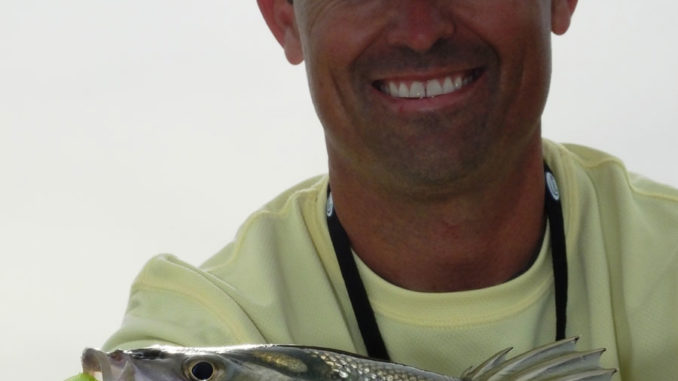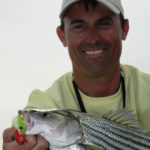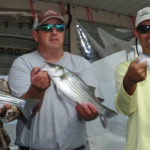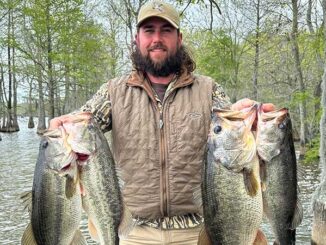
Regulations have worked, but it’s time for changes
Striper fishing opens Oct. 1 — the keeper season, that is — on the Santee Cooper lakes, but no legislation has been passed to update current, long-standing regulations. Many anglers were hoping for new regulations by the fall opening, but good news regarding the health of the striper fishery is available.
According to Scott Lamprecht, a fisheries biologist for the S.C. Department of Natural Resources whose territory includes Santee Cooper, the health of the fishery is very good.
“The striper fishing prospects are good for this fall and winter,” Lamprecht said. “Our winter gill-net surveys indicate we have strong year-classes from 2014 and 2015, with the 2016 class being a bit weaker. I am also encouraged about this spring’s stocking, because our hatchery was able to meet our request, and the fingerlings were exceptionally large, improving their potential for survival.”
Lamprecht said it was apparent during spring largemouth bass sampling that more adult threadfin shad are in the system than he’s seen in 15 years.
“Threadfin shad abundance is important to the growth and survival of several important species, including stripers,” he said. “This past summer, we also saw almost weekly hatches of mayflies on Lake Moultrie, and the juvenile stripers, along with many fish species, utilize this resource. This should significantly benefit the small stripers getting through their critical first summer, providing them with a steady food supply.
“The unprecedented number of mayfly hatches is a puzzle, but it’s usually associated with improved water quality, (and) it is excellent for fish production.”
Lamprecht said in the past two years, more stripers weighing 15 pounds or more have been caught than at any time in his career. Some were caught in the in late fall and winter, but the majority during the spring when stripers make their spawning runs up the Congaree and Wateree rivers.
“The current harvest restrictions have done their job in allowing striped bass to survive to older ages, however, an opportunity exists to loosen these regulations without losing the gains that have been made,” he said. “The fishery covers a large area of the state and is quite different along its length, producing a wide range of fishing tactics and with those, a wide range of angler preferences. Balancing those preferences with what the system can sustain is challenging.”
Lamprecht said the bad news isn’t really all that bad; harvest adjustments remain a work in progress. Unless emergency measures are passed, the season will open with the same three-fish, 26-inch minimum size that’s been in place the past nine seasons.
Lamprecht said the legislative process of changing regulations will likely be back on the table for action in January. He is hopeful new regulations will be in effect at some point in 2018.
“The Citizens Stakeholder Committee made a recommendation to the legislature,” Lamprecht said. “It proposed a three-fish daily limit with a 23- to 25-inch harvest slot (you can keep fish within the slot), with an allowance to keep one striper 34 inches or larger. Also, (it) would extend the spring season until June 15, instead of closing it on May 31. The House passed this version of the bill. ”
The Senate version differed, he said; a proposal was made to initiate a tagging system. Under this proposal, anglers would receive five tags to use during a given time frame, allowing them to keep five fish longer than 26 inches. Only one non-transferable tag per day could be used, and a slot limit would be in place for rest of the three-fish limit.
“The differences between the two bills could not be reconciled before the legislature ended this year’s session,” Lamprecht said. “It’s encouraging that the striped bass resource is doing so well an opportunity exists to adjust regulations put in place to recover from the historic lows seen just 10 years ago. However, we must tread lightly to ensure we don’t lose all the ground we’ve gained.”
Kevin Davis, owner of Blacks Camp and a long-time Santee Cooper guide, offered an opinion on striper legislation from the perspective of a fisherman and business owner.
“The (stakeholders committee) was formed 10 years ago to boost the population of stripers,” he said. “The whole premise was to ‘bank’ the brood fish. A 26-inch minimum size was created which, in effect, stopped striper removal in the Santee Cooper lakes.
“With no fishing pressure whatsoever, plus many years of successful spawns or stockings, (this) have resulted in a significant boost in the striper population,” Davis said. “We now have (lakes) absolutely full of stripers, but most of the time, you cannot catch one big enough to keep. Not many stripers grow to be 26 inches or larger in the Santee Cooper lakes. A few big fish are caught in the early spring, because every brood fish in the system is up the river trying to spawn. According to SCDNR, only 6 to 7 percent of the stripers in Santee Cooper are 26 inches or larger.
“When that small number of large stripers is in a river trying to spawn, they are most vulnerable to fishermen. The fact is, the stripers being harvested are genetically superior and lay many more eggs than smaller stripers. By harvesting only brood fish that have the necessary genes to produce large fish, we are systematically creating an inferior population that will be unable to produce big stripers.
“In short, the stakeholders committee was formed in order to leave the brood fish in the system, but with current laws, the only fish being harvested are the genetically superior brood fish,” Davis said. “It’s messed up when you consider the way the catch-and-release of trophy fish has taken off in other parts of the country. Santee Cooper fishermen need to follow the lead of bass and catfishermen when it comes to CPR: catch, photograph and release.”







Be the first to comment